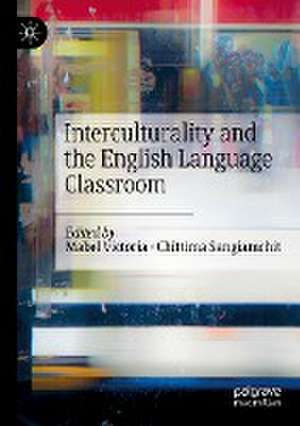Interculturality and the English Language Classroom
Editat de Mabel Victoria, Chittima Sangiamchiten Limba Engleză Paperback – 15 aug 2022
| Toate formatele și edițiile | Preț | Express |
|---|---|---|
| Paperback (1) | 890.54 lei 43-57 zile | |
| Springer International Publishing – 15 aug 2022 | 890.54 lei 43-57 zile | |
| Hardback (1) | 1003.24 lei 43-57 zile | |
| Springer International Publishing – 14 aug 2021 | 1003.24 lei 43-57 zile |
Preț: 890.54 lei
Preț vechi: 1086.03 lei
-18% Nou
Puncte Express: 1336
Preț estimativ în valută:
170.40€ • 178.39$ • 140.100£
170.40€ • 178.39$ • 140.100£
Carte tipărită la comandă
Livrare economică 07-21 aprilie
Preluare comenzi: 021 569.72.76
Specificații
ISBN-13: 9783030767594
ISBN-10: 3030767590
Ilustrații: XXV, 299 p. 15 illus., 3 illus. in color.
Dimensiuni: 148 x 210 mm
Greutate: 0.43 kg
Ediția:1st ed. 2021
Editura: Springer International Publishing
Colecția Palgrave Macmillan
Locul publicării:Cham, Switzerland
ISBN-10: 3030767590
Ilustrații: XXV, 299 p. 15 illus., 3 illus. in color.
Dimensiuni: 148 x 210 mm
Greutate: 0.43 kg
Ediția:1st ed. 2021
Editura: Springer International Publishing
Colecția Palgrave Macmillan
Locul publicării:Cham, Switzerland
Cuprins
Chapter 1: Interculturality and the English Language Classroom.- SECTION 1: TEACHER’S VOICES: EXPLORING WAYS TO RESEARCH INTERCULTURALITY IN ELT.- Chapter 2: A Cultural Studies Approach to Interculturality in ELT.- Chapter 3: ELT and Interculturality: Approaching such a (dis)connection through the Voices of future Brazilian Teachers of English.- Chapter 4: Interculturality and Professional Identity: Exploring the Potential of Telecollaboration in Foreign Language Teacher Education.- SECTION 2: INTEGRATING INTERCULTURALITY IN ELT TEXTBOOKS.- Chapter 5: Teaching Global issues for Intercultural Citizenship in a Tunisian EFL Textbook: “Skills for Life”. Chapter 6: Intercultural Competence in the Curriculum and in Textbooks – which Lessons can be Learnt from EFL Textbooks in Norwegian Schools?.- Chapter 7: Cultivating Critical Interculturality in Adult ESOL.- SECTION 3 THE ROLE OF ENGLISH IN LEARNING AND TEACHING OF INTERCULTURALITY.- Chapter 8: The ‘Intercultural’ and English as a Lingua Franca in International Higher Education: Expectations, Realities, and Implications for English Language Teaching.- Chapter 9: Moving from Cultural Ethnocentrism to Enthnorelativism through the Affordance of English Language Learning Experience.- Chapter 10: Using ‘Interculturality’ to increase the value of ELT in Academic Contexts.- Chapter 11: Conclusion: Interculturality and the English Language Classroom: Intercultural Approaches and Moving Forward.
Notă biografică
Mabel Victoria is a Lecturer at Edinburgh Napier University, UK. Her research interests are interdisciplinary —from latrinalia to linguistic landscapes to dark tourism, to classroom humour, to intercultural communication and English as a lingua franca. She has published in international journals like The ELT Journal, The Language Learning Journal and Globalisation, Societies and Education.
Chittima Sangiamchit is a Lecturer at University of the Thai Chamber of Commerce, Bangkok, Thailand. She has published and presented internationally on English as a Lingua Franca (ELF), online intercultural communication, English language teaching and English as a medium of instruction. Her recent work involves transcultural communication in a social network community.
Chittima Sangiamchit is a Lecturer at University of the Thai Chamber of Commerce, Bangkok, Thailand. She has published and presented internationally on English as a Lingua Franca (ELF), online intercultural communication, English language teaching and English as a medium of instruction. Her recent work involves transcultural communication in a social network community.
Textul de pe ultima copertă
This book examines the concept of interculturality in English Language Teaching (ELT), using examples from diverse international and educational settings to demonstrate different approaches. Increased contact between multilingual speakers from different cultural backgrounds means that linguistic and intercultural competence must be taught hand in hand, and the approaches featured here will: encourage learners to develop intercultural sensitivity and a critical intercultural attitude; mitigate the limitations of textbooks and extend the learning to global issues, intercultural citizenship, and media literacy; show the potential of telecollaboration and popular culture as pedagogical resources; and demonstrate the value of interculturality in English as lingua franca situations and English for Academic Purposes. The chapters feature empirical studies from around the world, and include questions for reflection and recommended reading so that readers can engage more closely with key concepts, compare and adapt the practices most relevant to them. This book contributes to the literature on (inter)cultural pedagogy, English as a lingua franca, language pedagogy, and teacher professional development, and will be an invaluable tool for English language teachers, teacher trainers and educators seeking to enrich their practice. It will also be of interest to students and scholars of Applied Linguistics, especially language education. Mabel Victoria is a Lecturer at Edinburgh Napier University, UK. Her research interests are interdisciplinary —from latrinalia to linguistic landscapes to dark tourism, to classroom humour, to intercultural communication and English as a lingua franca. She has published in international journals like The ELT Journal, The Language Learning Journal and Globalisation, Societies and Education.
Chittima Sangiamchit is a Lecturer at University of the Thai Chamber of Commerce, Bangkok, Thailand. She haspublished and presented internationally on English as a Lingua Franca (ELF), online intercultural communication, English language teaching and English as a medium of instruction. Her recent work involves transcultural communication in a social network community.
Chittima Sangiamchit is a Lecturer at University of the Thai Chamber of Commerce, Bangkok, Thailand. She haspublished and presented internationally on English as a Lingua Franca (ELF), online intercultural communication, English language teaching and English as a medium of instruction. Her recent work involves transcultural communication in a social network community.
Caracteristici
Compares diverse approaches to interculturality in ELT Brings together contributors from a variety of countries and regions Includes the practical experiences of educators from different educational settings
